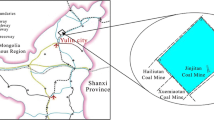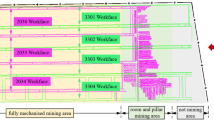Abstract
In situ measurements of deformations, stresses, and closure of fractures, affecting water inflow following coal mining, are challenging due to the inaccessibility of fractured rock. In this paper, the authors studied the closure process of the fractured rock mass with the cover stress re-establishment based on a theoretical analysis and a scale model testing. A quantitative analysis is used to study the fracture distribution in the fractured zone. A function to describe a fracture aperture distribution in the fractured zone is proposed, which takes into account the curvature and thickness of the fractured rock. The theoretical analysis and a scale model testing both indicate that the cover stress re-establishment with mining distance increasing and the relationship between the fracture closure and cover stress re-establishment both satisfy a logarithmic function. The scale model test also shows the following features: (1) the fracture ratio (which is the fracture area divided by the total area of fracture and intact rock with a unit width in the vertical or horizontal direction) in the lower part of the fractured rock mass is greater than that in the upper part; (2) the initially fast decreased of fracture ratios is then followed by a slower decrease during the cover stress re-establishment process; (3) in the upper part of the rock mass, the vertical directional fractures with small apertures are being closed with cover stress re-establishment, which indicates an increase in the water resistance reducing the seepage from these parts of the fractured zone. This study improves the general understanding of the fracture closure process and cover stress re-establishment in the fractured rock mass after coal mining ceased, and provides a theoretical basis for water resource protection in case of underground coal mining.

















Similar content being viewed by others
References
Alireza B, Lanru J (2008) Stress effects on permeability in a fractures rock mass with correlated fracture length and aperture. Int J Rock Mech Min Sci 45:1320–1334
Bandis SC, Lumsden AC, Barton NR (1983) Fundamentals of rock joint deformation. Int J Rock Mech Min Sci Géoméch Abstr 20(6):249–268
Karacan CÖ, Goodman G (2009) Hydraulic conductivity changes and influencing factors in longwall overburden determined by slug tests in gob gas ventholes. Int J Rock Mech Min Sci 46(7):1162–1174
Kim JM, Parizek RR, Elsworth D (1997) Evaluation of fully-coupled strata deformation and groundwater flow in response to longwall mining. Int J Rock Mech Min Sci 34(8):1187–1199
Liu J, Elsworth D (1997) Three-dimensional effects of hydraulic conductivity enhancement and desaturation around mined panels. Int J Rock Mech Min Sci 34(8):1139–1152
Liu J, Elsworth D, Brady BH (1999) Linking stress-dependent effective porosity and hydraulic conductivity fields to RMR. Int J Rock Mech Min Sci 36(5):581–596
Majdi A, Hassani FP, Nasiri MY (2012) Prediction of the height of destressed zone above the mined panel roof in longwall coal mining. Int J Coal Geol 98:62–72
Miao X, Cui X, Wang J et al (2011) The height of fractured water-conducting zone in undermined rock strata. Eng Geol 120(1):32–39
Palchik V (2003) Formation of fractured zones in overburden due to longwall mining. Environ Geol 44(1):28–38
Peng SS, Chiang HS (1984) Longwall mining. Wiley, New York
Philippe S, Aurélien B, Rodolphe C et al (2011) In-situ characterization of the effective elasticity of a fault zone, and its relationship to fracture spacing. J Struct Geol 33:1541–1553
Qian M-G, Miao X-X, Xu J-L (1996) Theoretical study of key stratum in ground control. J China Coal Soc 21(3):225–230 (in Chinese)
Salamon MDG (1990) Mechanism of caving in longwall coal mining. In: Rock mechanics contributions and challenges: proceedings of the 31st US symposium. Golden, Colorado, pp 161–168
Sui W-H, Hang Y, Ma L-X et al (2015) Interactions of overburden failure zones due to multiple-seam mining using longwall caving. Bull Eng Geol Environ 74(3):1019–1035
Wang W-X, Sui W-H, Dong Q-H et al (2013) Closure effect of mining-induced fractures under sand aquifers and prediction of overburden failure due to re-mining. J China Coal Soc 38(10):1723–1729 (in Chinese)
Wang W-X, Sui W-H, Dong Q-H et al (2014) Influence of cover stress re-establishment on the permeability evolution of the mining-induced fractures. J China Coal Soc 39(06):1031–1038 (in Chinese)
Wang W-X, Sui W-H, Faybishenko B et al (2016) Permeability variations within mining-induced fractured rock mass and its influence on groundwater inrush. Environ Earth Sci 75(4):1–15. doi:10.1007/s12665-015-5064-5
Wilson AH (1983) The stability of underground workings in the soft rocks of the coal measures. Int J Min Eng 1(2):91–187
Worthington MH, Lubbe R (2007) The scaling of fracture compliance. Geol Soc Lond Spec Publ 270:73–82
Yavuz H (2004) An estimation method for cover pressure re-establishment distance and pressure distribution in the goaf of longwall coal mines. Int J Rock Mech Min Sci 41(2):193–205
Zhang J, Shen B (2004) Coal mining under aquifers in China: a case study. Int J Rock Mech Min Sci 41(4):629–639
Zhang D-S, Fan G-W, Ma L-Q et al (2009a) Harmony of large-scale underground mining and surface ecological environment protection in desert district-a case study in Shendong mining area, northwest of China. Procedia Earth Planet Sci 1(1):1114–1120
Zhang D-S, Ma L-Q, Wang X-F et al (2009b) Aquifer-protective mining technique and its application in shallowly buried coal seams in Northwest of China. Procedia Earth Planet Sci 1(1):60–67
Zhang D-S, Fan G-W, Liu Y-D et al (2010) Field trials of aquifer protection in longwall mining of shallow coal seams in China. Int J Rock Mech Min Sci 47(6):908–914
Zhang D-S, Fan G-W, Ma L-Q et al (2011) Aquifer protection during longwall mining of shallow coal seams: a case study in the Shendong Coalfield of China. Int J Coal Geol 86(2):190–196
Acknowledgments
The high-level personnel scientific research startup project of North China University of Water Resources and Electric Power (40470), Henan institution of higher education key scientific research project (16A410004) and an open project funding from Chinese Research Center on Levee Safety and Disaster Prevention of Ministry of Water Resources are acknowledged. The authors sincerely thank Gregory Weissmann and Trevor Mone of the University of the Pacific for their editorial help.
Author information
Authors and Affiliations
Corresponding author
Rights and permissions
About this article
Cite this article
Wang, W., Jiang, T., Faybishenko, B. et al. Closure of Fracture Due to Cover Stress Re-establishment After Coal Mining. Geotech Geol Eng 34, 1525–1537 (2016). https://doi.org/10.1007/s10706-016-0059-x
Received:
Accepted:
Published:
Issue Date:
DOI: https://doi.org/10.1007/s10706-016-0059-x




